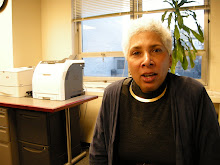American Folk Art Museum
Women Only: Folk Art by Female Hands
Through September 12, 2010
There is a welcoming statue of a full figured woman standing atop a ballot box on the third floor exhibit of Folk Art by Female Hands. The theme of this exhibit was inspired by the novel An Old Fashioned Girl by L. M. Alcott. In Chapter 13 of there is a scene where Fanny and Polly visit the studio of Becky and Bess. Becky with clay soaked hands is sculpting a statue of "the coming woman." Fanny describes the statue "it is only a beautiful woman, bigger, lovelier and more imposing than any woman I ever saw." The women discuss "what women should be?" "Give her a ballot box," suggested Kate King, the authoress. Becky agrees, " a needle, pen, palette, broom and a ballot box."
The exhibit introduces us to a portrait of Grandma Moses, who is credited with starting the canon of folk art according to the Senior curator Stacy C. Hollander. Grandma Moses did needlework before painting in oil and tempera.
Finishing the Quilt by Nan Phelps of Hamilton, Ohio, oil on canvas shows three generations of women seated and hand quilting.
Next to this piece hangs a silk quilt from the Museum of Folk Art collection entitled Stars and Pentagons. The patterns in this tautly stretched quilt are similar to Finishing the Quilt.
In the past centuries the homes of women displayed the practical skills of producing domestic textiles. These works combined practicality with ornamental creations. We now appreciate this beauty;' the cult of domesticity.'
Women were educated in the ornamental arts of needlework by stitching a "sampler." A sampler included the stitching of the letters of the alphabet, numbers and figures. These schools such as the Sanders and Beech School; Sarah Pierce's Female Academy in Litchfield, Connecticut or the Ladies Academy in Dorchester, Massachusetts also taught the classics. Some to the pieces exhibited show needlework plus watercolor paintings on linen. Watercolor Studies by Mary Nettleson from the Wesleyan Academy in Wilbraham, Massachusetts.
There is a section about how the women used there needlework skills to teach morals and religious mythology to their families. The large hand stitched quilt by Maria Cadman Hubbard in 1848 depicts pious quotes, aphorisms and proverbs. "If you can not be a golden pippin. Do not turn crab apple." The letters are inches tall.
The quilt artist signed her tribute to the Grover Cleveland presidential campaign J.F.R. During the 1880-90's her "stash" included ribbons associated with political
events in the Democratic Party. There are irregular patches of silks and other fabrics outlined with embroidery threads.
A demure crazy quilted robe hangs on a mannequin. It was worn by Emma Rebecca Cummins Blacklock Snively Crosier Pauling. She was not a 'waiting' woman of the Gold Rush Days. She won her third husband in a bar room brawl. She was the first female telegraph operator for the railroad.
Theorem Painting during the period of 1825-1840 used hollow cut stencils to produce still life watercolor paintings on velvet fabric. The math formulas provided the sharp delineation of each object.
Diamond in the Square Quilt by an unknown quilter of Lancaster, Pennsylvania is dated between 1910-1930. The large geometric patterns in single-color fabrics of saturated earth and jewel tones are typical of contemporary Amish quilts. This pattern is related to the tooled leather designs found on covers of the Ausbund, the early Anabaptist hymnal.
The closing of the exhibit features portrait paintings in watercolor, pencil and ink.
American Folk Art Museum is located at 45 West 53rd Street/Sixth Avenue, New York, NY 212.265.1040. The exhibit runs until September 12, 2010.
Thursday, May 6, 2010
Subscribe to:
Post Comments (Atom)

No comments:
Post a Comment